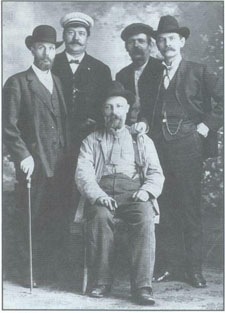|
Illinois Issues Summer Book Section
Chicago:
a door for
Swedish
Americans
By H. ARNOLD BARTON
Philip J. Anderson and Dag Blanck
(eds.). Swedish-American Life in Chicago: Cultural and Urban Aspects of an
Immigrant People, 1850-1930. Urbana
and Chicago: University of Illinois Press,
1992. Pp. 394 with illustrations, notes
and index. $42.50 (cloth).
Chicago holds a unique place in
the history of Swedish immigration to America. In 1890
Swedes comprised the third largest immigrant group, after the Germans and
Irish, in a city one-third of whose inhabitants were foreign-born. In 1900 Chicago was after Stockholm the
world's largest "Swedish" city. Hence a
broad study of Chicago's Swedish element is an invaluable addition to the
University of Illinois Press's new "Ethnic History of Chicago" series.
From a Swedish-American viewpoint, this book is of particular significance. By 1910, close to 10 percent of
America's Swedish population lived in
Chicago, not counting its independent
suburbs. A large proportion of the
Swedish immigrants to America passed
through the city or at one time resided
there. Familiarity with Chicago was
thus a common denominator of the
Swedish-American experience. Moreover, Chicago was, almost from the
beginning of the great Swedish migration in the 1840s, the undisputed "capital" of Swedish America, the nerve center of an entire ethnic culture.
This latter aspect makes Swedish
Chicago particularly relevant to the
present state of Swedish-American studies. Following pioneering work on the
subject by Swedish-American historians much of it pursued by avocation
only scholars in Sweden became
seriously interested in the Swedish-American experience by the 1960s,
concentrating at first on statistical analysis of the emigration. Over the last
decade, however, interest both in Sweden and America has turned increasingly
not only to the immigrants' cultural life
but to the very creation of their ethnic
identity. The present volume provides a
guide to and a sampling of these new
directions, which are summarized by
the editors in their fine integrating introduction.
Over the last decade, however,
interest both in Sweden and
America has turned increasingly
not only to the immigrants'
cultural life but to the very
creation of their ethnic identity
|
The book consists of 24 contributions by American and Swedish scholars to a conference sponsored by the
Swedish-American Historical Society at
Chicago's North Park College in 1988.
A wide variety of topics are covered,
including the socioeconomic structure
of Chicago's Swedish ethnic community, its religious life, secular societies,
literary activity, theater, educational institutions, labor organizations, leading
personalities, and relations with other
ethnic groups, as well as the image of
Chicago in Sweden created by travel
accounts and by both Swedish and
American fiction.
Still, as the editors admit, significant
topics await further exploration. Fore-
|
July 1993/Illinois Issues/31
most among these, in my view, would
be the Swedish-American newspapers,
comprising the second largest ethnic
press in America, after the German,
according to a recent study, and
strongly centered in Chicago; Swedish-American musical life, especially the
flourishing choral societies; and Swedish-American business enterprises and
their role in promoting ethnic life. The
present volume is no less welcome for
revealing such uncharted vistas.
 Courtesy of the Nordiska Museets Arkiv/Nordic
Courtesy of the Nordiska Museets Arkiv/Nordic
Museum Archives,
Stockholm, Sweden
Swedes worked many trades in Chicago. This photograph from
the end of the 19th century shows representatives from four
different skilled professions. Pictured on the far left is August
Palm, the leader of the labor movement in Sweden, who visited
Chicago in 1900.
|
While recognizing the high overall
quality of the contributions, I find some
of the essays especially suggestive. Beginning in 1880, where Ulf Beijbom's
groundbreaking 1971 study Swedes in
Chicago left off, Anita R. Olson traces
the progressive suburbanization of Chicago's Swedish population to 1920,
showing how geographic dispersal was
counterbalanced by the creation of a
citywide, institutional ethnic community. In a broad-ranging survey, Harald
Runblom compares the situation of Swedes in Chicago with that of other ethnic
groups in the city, as well as
of Swedes in smaller, more
ethnically concentrated
North American cities. Per
Nordahl makes a strong
case for the characteristically Swedish style of labor
organization and the idealism of Swedish-dominated
locals in the Chicago building trades.
In addition, Eric Johannesson and Dag Blanck
provide a fascinating analysis of the ethnic symbolism
and rhetoric surrounding,
respectively, erection of the
statue of Carl Linnaeus (the
great 18th-century Swedish
botanist) in Lincoln Park in
1891 and Swedish participation in the World's Columbian Exposition in
1893. Eric R. Lund challenges the stereotype of
Swedish-American political
naivete and apathy in his
treatment of the Swedish-born Fred Lundin, the kingmaker behind Mayor W.H.
("Big Bill") Thompson's
elections in 1915 and 1919.
Timothy J. Johnson and Byron J. Nordstrom point up the differences between
the broad-based, fraternal Svithiod
Order and the elite, cosmopolitan
Swedish Engineers' Society of Chicago.
The Swedes in America have traditionally been viewed and have
viewed themselves as rural pioneers
on the Midwestern frontier. Still, by
1910, some 60 per cent of them had
already become urban dwellers. Anderson and Blanck's welcome and valuable
collection redresses the balance, not
only in its specific focus upon Chicago,
but by illuminating, in absorbing detail,
the entire urban dimension of the
Swedish-American experience and its
central significance for the cultural life
of the ethnic group as a whole.
|
H. Arnold Barton is professor of history at
Southern Illinois University in Carbondale.
He served as editor of the Swedish-American
Historical Quarterly from 1974 to 1990.
32/July 1993/Illinois Issues
|

